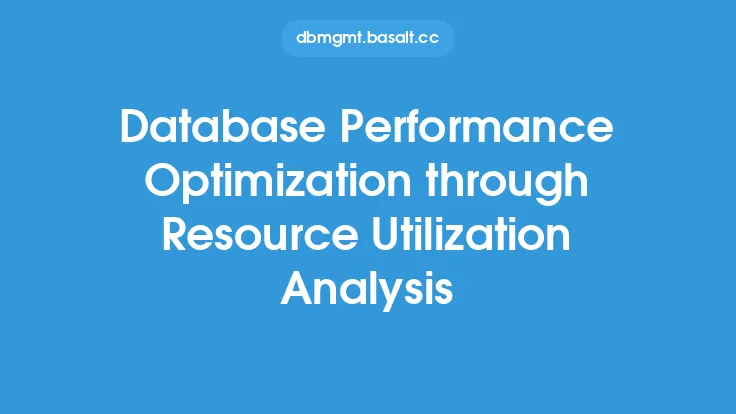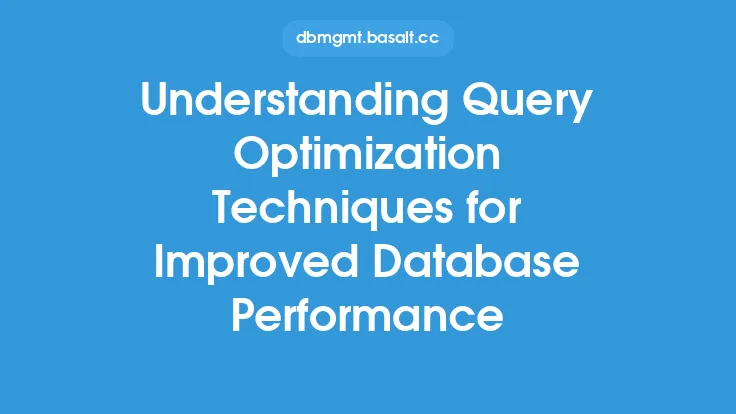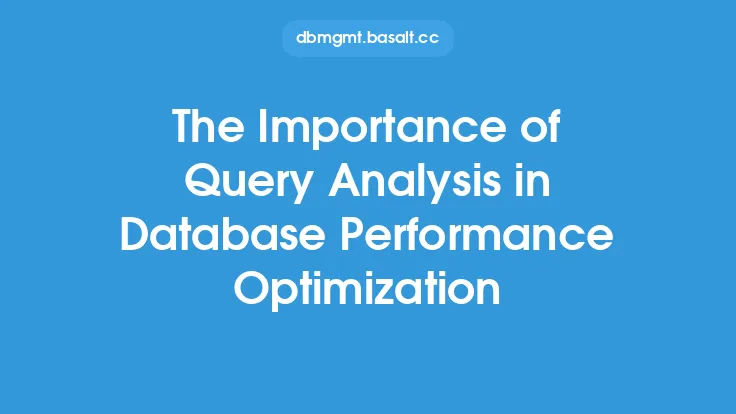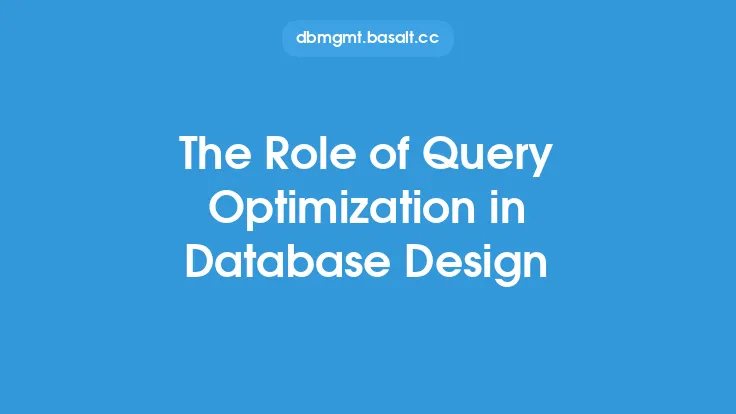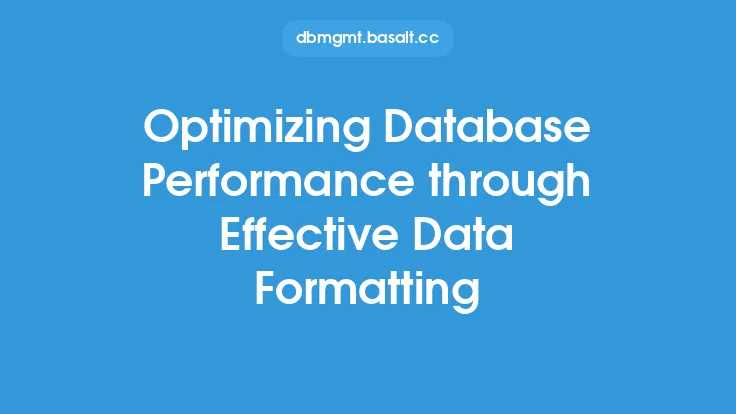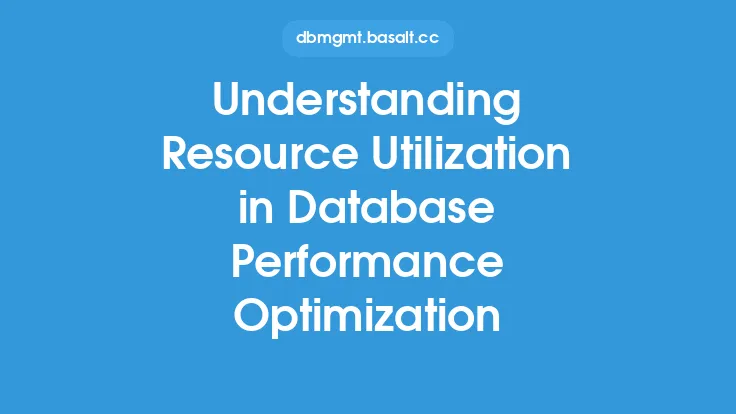Database performance is a critical aspect of any application or system that relies on data storage and retrieval. One of the key factors that can significantly impact database performance is the efficiency of the queries used to access and manipulate data. Query optimization is the process of analyzing and improving the performance of database queries to reduce execution time, improve responsiveness, and increase overall system throughput. In this article, we will delve into the world of query optimization and explore the various techniques and strategies that can be employed to improve database performance.
Introduction to Query Optimization
Query optimization is a complex process that involves understanding the database schema, the query workload, and the underlying system architecture. It requires a deep understanding of the query language, database internals, and the performance characteristics of the system. The goal of query optimization is to minimize the time it takes to execute a query, while also minimizing the resources required to execute the query. This can be achieved by reducing the number of disk I/O operations, minimizing the amount of data that needs to be transferred, and optimizing the use of system resources such as CPU and memory.
Understanding Query Execution Plans
A query execution plan is a detailed outline of the steps that the database will take to execute a query. It includes information such as the order in which tables will be accessed, the join methods that will be used, and the indexes that will be utilized. Understanding query execution plans is critical to query optimization, as it allows developers and database administrators to identify performance bottlenecks and optimize the query accordingly. There are several tools and techniques that can be used to analyze query execution plans, including the EXPLAIN statement, which provides a detailed breakdown of the query execution plan, and the ANALYZE statement, which provides information about the query execution time and resource usage.
Indexing and Statistics
Indexing and statistics are two critical components of query optimization. Indexes are data structures that improve the speed of data retrieval by providing a quick way to locate specific data. There are several types of indexes, including B-tree indexes, hash indexes, and full-text indexes, each with its own strengths and weaknesses. Statistics, on the other hand, provide information about the distribution of data in the database, which is used by the query optimizer to make informed decisions about the best execution plan. Accurate and up-to-date statistics are critical to query optimization, as they allow the query optimizer to make informed decisions about the best execution plan.
Query Optimization Techniques
There are several query optimization techniques that can be employed to improve database performance. These include:
- Reordering joins: Reordering the joins in a query can significantly impact performance, as it can reduce the number of rows that need to be joined and improve the efficiency of the join operation.
- Using indexes: Indexes can significantly improve the speed of data retrieval, but they can also slow down write operations. Therefore, it is critical to carefully consider which columns to index and when to use indexes.
- Optimizing subqueries: Subqueries can be slow and resource-intensive, but they can also be optimized using techniques such as rewriting the subquery as a join or using a common table expression.
- Using query hints: Query hints are instructions that are provided to the query optimizer to influence the execution plan. They can be used to specify the join order, the index to use, or the query optimization technique to employ.
Database Design and Query Optimization
Database design plays a critical role in query optimization, as a well-designed database can significantly improve query performance. A well-designed database should have a clear and consistent schema, with each table having a clear and well-defined purpose. The database should also be normalized to minimize data redundancy and improve data integrity. Additionally, the database should be designed with query optimization in mind, with indexes and statistics carefully considered to support the query workload.
Monitoring and Analyzing Query Performance
Monitoring and analyzing query performance is critical to query optimization, as it allows developers and database administrators to identify performance bottlenecks and optimize the query accordingly. There are several tools and techniques that can be used to monitor and analyze query performance, including query logs, performance monitoring tools, and benchmarking tools. These tools provide information about query execution time, resource usage, and performance metrics, which can be used to identify areas for improvement and optimize the query.
Best Practices for Query Optimization
There are several best practices that can be employed to improve query optimization, including:
- Use efficient join methods: The join method used can significantly impact query performance, with some methods being more efficient than others.
- Avoid using SELECT \*: Selecting all columns can slow down query performance, as it requires the database to retrieve more data than necessary.
- Use indexes carefully: Indexes can improve query performance, but they can also slow down write operations.
- Optimize subqueries: Subqueries can be slow and resource-intensive, but they can also be optimized using techniques such as rewriting the subquery as a join or using a common table expression.
Conclusion
Query optimization is a critical aspect of database performance, and it requires a deep understanding of the database schema, the query workload, and the underlying system architecture. By employing techniques such as reordering joins, using indexes, optimizing subqueries, and using query hints, developers and database administrators can significantly improve query performance and reduce execution time. Additionally, monitoring and analyzing query performance, and following best practices for query optimization, can help to identify areas for improvement and optimize the query accordingly. By taking a proactive approach to query optimization, organizations can improve database performance, reduce costs, and improve overall system throughput.
